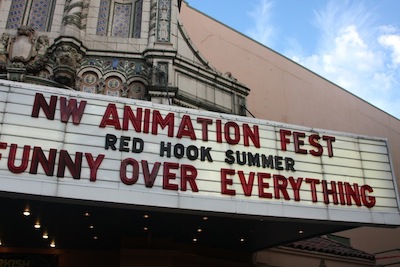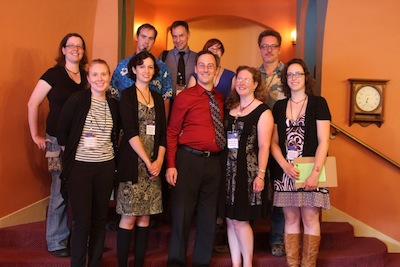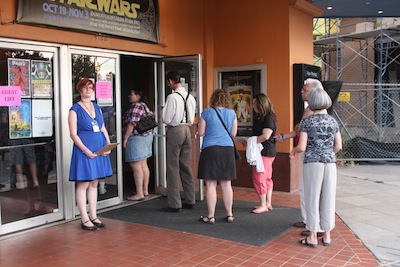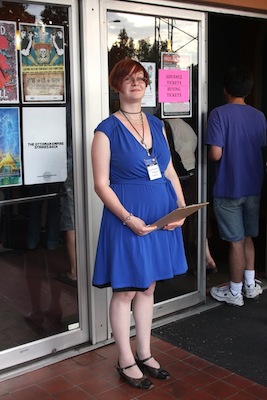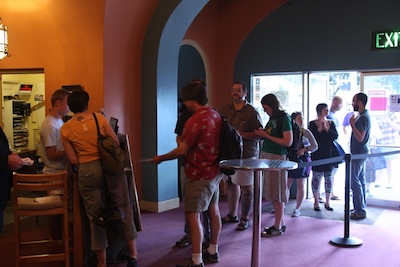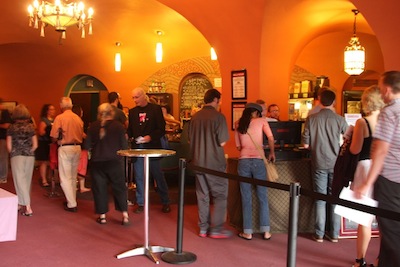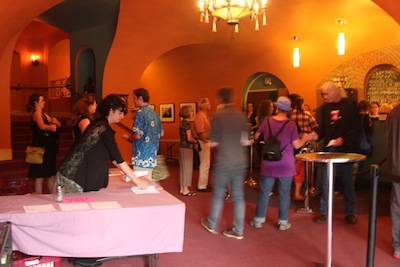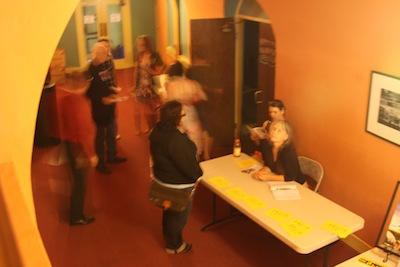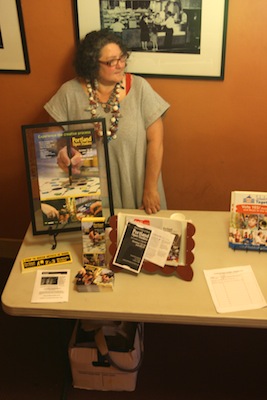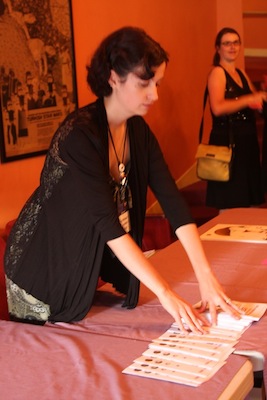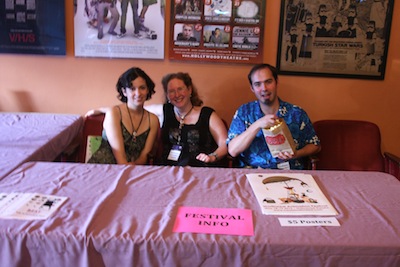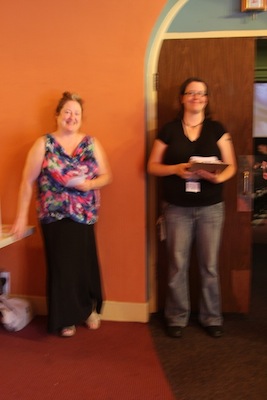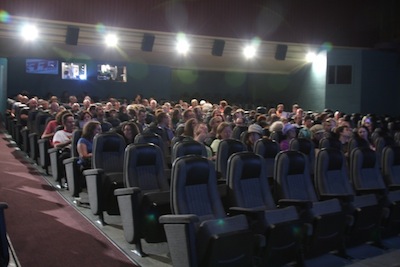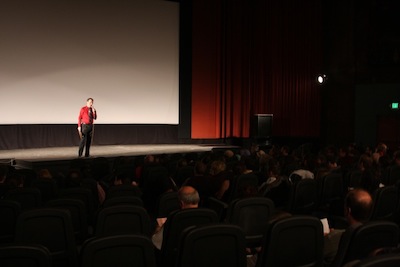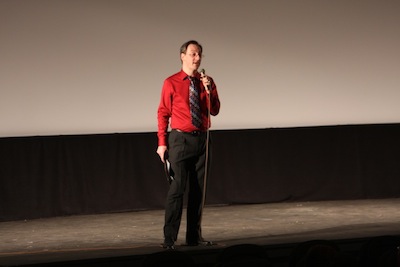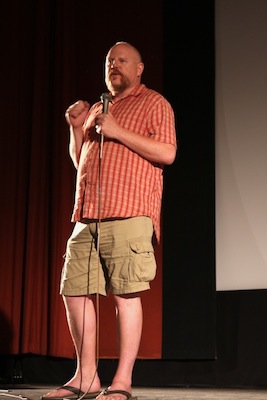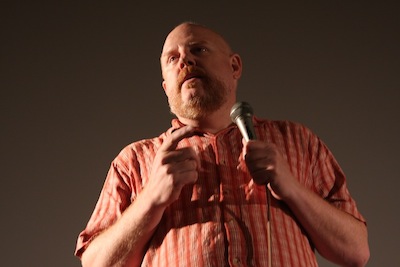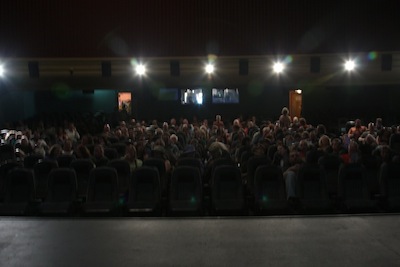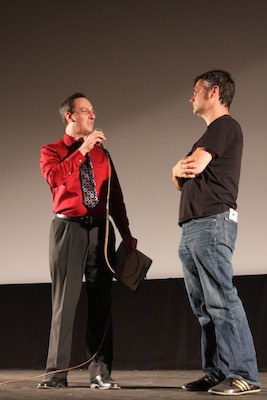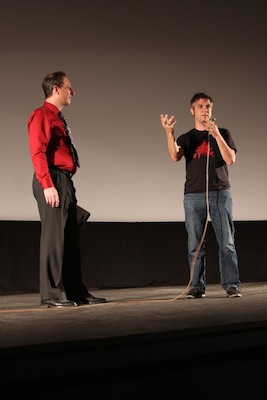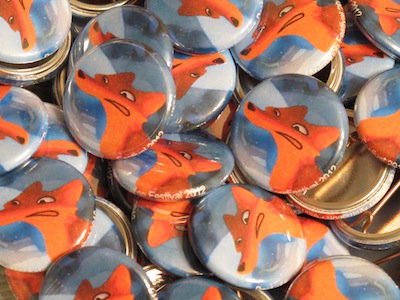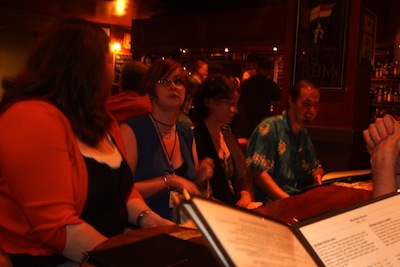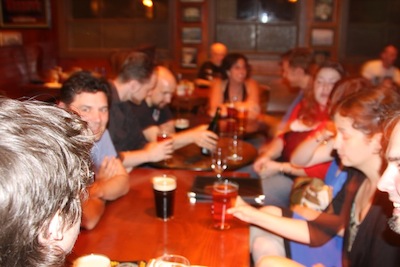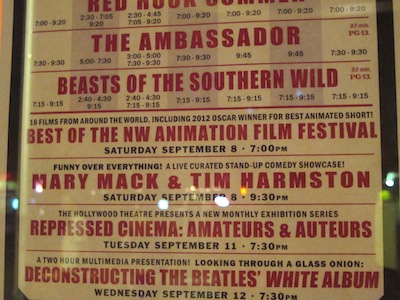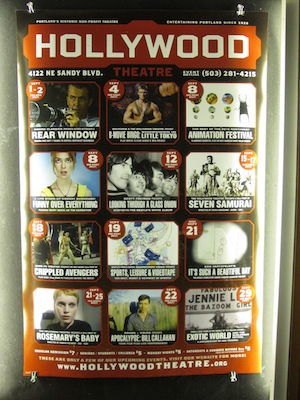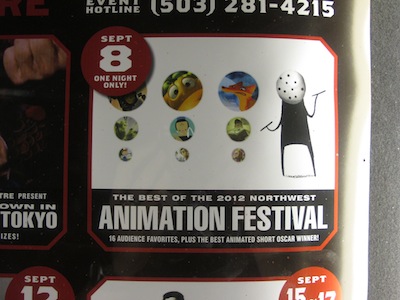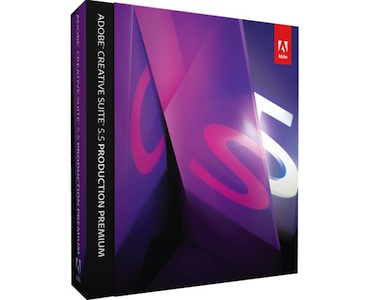September 2012 archives
you are here [x]: Scarlet Star Studios > the Scarlet Letters > September 2012
<< before
August 2012
after >>
December 2012
September 11, 2012
review: best of the nw animation festival 2012
by sven at 1:28 pm

This past Sunday's "Best of the Fest" show went quite well.
I work hard to make sure every show is better than the last. Here's how we grew this time around:
- attendance
By my count, we filled 196 seats. I believe this is the largest turn-out we've had to date. That's 171 paid tickets, 14 guests, 10 event staff, and 1 theater representative. I've estimated our NWAF12 shows in May at roughly 200 attendees each night. However, the exact numbers are uncertain. Friday and Saturday ticket sales were 129 and 140 — but we had much better guest turn-out than this past weekend. An improved guest book system means that that the head count this time around is much more accurate.
- blu-ray projection
This was our first time projecting from Blu-ray. Whereas a pro-level computer-driven playlist introduced minor static between films at NWAF12, using consumer-grade discs on a lowest-common-denominator technology provided a seamless stream. The Hollywood Theatre's digital projector has a maximum resolution of 1280x1024, which means anything larger than a 1280x720 Blu-ray is overkill, anyway. After much research, I believe I've also found the best solution for converting 25fps films to a 24fps standard. From a technical standpoint, this was our most flawless presentation of films yet.
2. Hollywood Theatre marquee
- community partners
In an effort to reach new audiences, I made cross-promotional deals with 11 arts organizations and 4 film festivals. I provided screen ads in exchange for mentions in newsletters and social media. The number of attendees garnered from any one deal was in the single digits. Yet, based on the size of these mailing lists, we probably reached more than 10,000 people who hadn't previously heard of NWAF.
- Hollywood Theatre collaboration
This summer Justen Harn from the Hollywood Theatre approached me with a proposal to form a closer relationship with the venue. Instead of paying 100% of rent up front, we get the space for free and split ticket sales 50/50. Given that 2hours in the main auditorium now costs $800, not having to worry about breaking even was a huge relief. (The new relationship also paves the way for a much bigger event in 2013).
3. Event staff: (front, L to R) Carly J. Cais, Temris Ridge, Sven Bonnichsen, Gretchin Lair, Becky Steele; (back row) Danie West, Nick Doggerpuss Nall, Brad Bolchunos, Christina Beard, Bill Womack
Ten people were on the event staff: Christina Beard, Brad Bolchunos, Carly J. Cais, Gretchin Lair, Nick Nall, Temris Ridge, Becky Steele, Danie West, Bill Womack and myself. It's a large team — but I've learned that simultaneously losing three people to personal emergencies is a very real possibility — so I lean on the side of safety.
We gathered at Magnolia's Corner immediately across from the theatre at 5:30pm. I should have allowed more time. The wine bar is typically staffed by the owner, and only has one stove. We needed more time to get everyone fed and get bills paid. We wound up heading over to the theatre at 6:15, and had very little time to get oriented before the audience started arriving.
Awkwardly, I had to be watching through the window at Magnolia's to see when info table staff from other organizations arrived. I needed to leave my food and cross the street to welcome them and help set up. Next time around I either need to keep someone posted at the theatre from 5:30 on — or I need to dictate that tablers have a specific time window in which to set up.
4. event staff clipboards
At NWAF12 I started giving everyone on the event staff a clipboard of their own. Everyone needs a "reserved" sign for their seat, a schedule and a program of films. Certain roles (Lobby Leader, Guest List, Front Door) get additional handouts. The clipboards are a good way to bind all these papers together — and help make the staff feel like they've got authority.
I improved on the clipboard concept this time by also giving each volunteer a written description of their responsibilities. I think this is going to be important at NWAF 2013, when I have to find volunteers to cover three days. It's very likely that I'll accidentally neglect to give someone an orientation. The written description should help get people up to speed if I'm absent.
The one hitch was that people didn't have enough time to read the descriptions thoroughly when we got to the theatre. I should have handed them out when we were still at Magnolia's Corner, and done Q&A while people ate.
Another tweak was that I gave each volunteer a sign with their name on it for claiming their seat (rather than just a "reserved" sign). This made it much easier to give each person the appropriate clipboard. However, it would have been smart to also label the clipboard itself, since there were a number of times when one was left lying on a table and it wasn't obvious who it belonged to.
It would have been nice to provide "reserved" signs for the info table folk as well. Telling them how many seats are reserved for each organization might be a diplomatic way to clearly limit how many volunteers each brings along.
5. the line to get into the theatre
At Best of the Fest 2011, we had a long line waiting to get into the show and had to start 15 minutes late. That hasn't been a problem since. Why? Were the doors locked last year until a certain time? Were people just exceptionally tardy, arriving at the last minute? I'm not sure. Whatever the case, we had no troubles with lines this time, and started only 5 minutes past showtime, allowing for stragglers.
6. Christina Beard welcomes attendees
At NWAF 2012 we had two volunteers staffing the door... Unfortunately it felt a little like they were guarding the doors rather than welcoming people in. This time we only had one person out front, and that was plenty.
7. purchasing tickets at the box office
At NWAF 2012, spare volunteers had a tendency to clump in the lobby, talking to each other. It impeded traffic and didn't look professional. So this time I specifically asked people to avoid doing this, and to seat themselves out of the main flow if they didn't have anything to do. That problem was largely solved.
There was still more wandering than I would have liked, though. Back in January — when we were having a technical crisis at Portland Animation Now! — I physically walked volunteers to their post and told them to be "locked down" there. If we have adequate orientation time next year, it would probably be a good idea to do a similar "locking" process again.
8. lobby as people are arriving - concessions
My back-up people were most likely to come out from the auditorium to check if they were needed. I should define their station better. Temris needed to abandon her post with the guest list in order to help ASIFA bring in T-shirts. That revealed a flaw in the "written responsibilities" plan: Gretchin hadn't been briefed about the Guest List position and was unclear about how to take over. Someone from the Hollywood Staff told Christina she should come inside — probably because they were trying to be kind, not because she was doing anything wrong — and I wound up sending her back outside again.
I want to be very clear that my staff are in no way at fault for moving around! My goal is simply to record these movements, so I can find ways to further minimize chaos as the event grows larger.
9. lobby as people are arriving - info table
Since moving to the Hollywood Theatre, I've invited ASIFA-Portland to have an info table at each event, hoping to help independent animators connect to an organized community. Having just one organization in the hallway between the auditorium doors seemed a little... sad. This year, with so many more community organizations involved, I was able to squeeze five groups in: ASIFA-Portland, Cascade ACM SIGGRAPH, the Oregon Cartoon Institute, Portland Open Studios, and Schools and Arts Together. I haven't had a chance to debrief with the people who tabled, but it certainly presented a more lively impression.
10. Anne Richardson and Carye Bye representing Oregon Cartoon Institute
11. Wendy Robinson of Portland Open Studios
One thing I didn't foresee was that info table folk would want to be handing out flyers for their own events. One of my staff alerted me that another org's volunteer was blocking attendees' path, handing them flyers as soon as they'd purchased their tickets. I can't fault his zeal — but asked the fellow to move back to the hallway so people could move through freely. Now I know to set clearer boundaries about where tablers are allowed to interact with attendees.
12. Temris Ridge laying out programs at the guest list table
We had one door marked for people with advance tickets or buying tickets, and another door for folks on the guest list. At previous events, guests would say their name aloud and our volunteer would cross their name off a list. It was awkward, because you can't always intuit how a name is spelled — and if the line is busy, it's easy to miss crossing someone off. So this time I simply had the guest list laid out on the table and told Temris that the job was to make sure everyone coming through signed their name. I think this worked out much better. It also made it easy for me to pop over to the guest list table to see who was in the audience that I might have missed coming through.
The one problem that needs to be solved here is that a surprising number of people show up after the show starts. If my volunteers are in the auditorium watching films, there's no one to collect signatures, and I don't get an accurate head count. I don't really like the idea of keeping someone out in the lobby. I might be able to coordinate with the Hollywood Theatre staff at the box office, asking them to collect signatures. (I give them a spare copy of the list anyway.)
Previously I've only put people on the guest list if they sent a RSVP. Having discovered that many folks can't commit until the last minute, this time I said RSVPs were appreciated but not required. About a third of invitees RSVP'd "no" (due to other obligations), a third said yes, and a third didn't reply. Much to my surprise, only half of those who said yes actually showed up. We didn't see anyone showing up who hadn't RSVP'd. What I take from this is that I can afford to be pretty generous with sending out invitations; it spreads a lot of good will without necessarily eating up a lot of seats.
13. Gretchin Lair, Temris Ridge, Nick Nall — and popcorn!
Gretchin had a great idea that I'll be repeating at future events. It occurred to her that event staff never have a chance to go through the concessions line to get popcorn. Our runner, Nick, didn't have anything to do just then, so she sent him around to take orders. Brilliant! It was a lovely treat this time around... Having a "Food Runner" who can go out to grab food at the nearby fast food restaurants will be even more important in 2013, when volunteers are hunkered down for 3 days.
14. Demetra Arnett (SIGGRAPH) and Danie West (NWAF) at the doors to the auditorium
At NWAF12 we had gorgeous programs printed by Morel Ink. This time around, my timeline was too tight to work with a professional printer, so I reverted to using the color laser printer in our office. I habitually print too many programs. I intended to only print 200 this time, figuring that people tend to share. At the last minute I lost my resolve and printed 275, just to be safe. I shouldn't have second guessed myself!
After the cost of space, programs are one of the biggest expenses associated with running the show. Trying to figure out what I'm spending on ink cartridges, internet research suggests we're looking at at least 15¢ per page. So it seems that programs cost at least 60¢ apiece (probably more, given how many photos I include) — $165+ in all. At this point in NWAF's development, that's not small change.
Even so, I feel it's important to have some sort of archival document of the program... Much like a museum catalog when you go to an exhibition. Larger festivals sell book-like programs separately; I don't think we've reached that point yet.
15. the audience beginning to fill the auditorium
In the auditorium, we had a pre-show reel of ads from our sponsors and community partners playing on repeat. The theatre has a separate, smaller projector that they use for just this purpose, which makes it easy to start the film program without switching settings. However, after the show I realized that it's entirely possible to have both the films and the ads formatted at 1280x720 — so next year I could perhaps offer advertisers higher resolution.
Some of the artwork I received went right up to the edges of the screen. It didn't occur to me that most people have never heard of TV-safe areas. I suspected (and had my fingers crossed) that projectors don't have the same issue as televisions. Happily I was right — none of the artwork got cut off.
To keep things interesting for the audience, for every five advertisements I included a still image from one of the films. Thinking that people would be more likely to look at the screen when a picture was up, I privileged sponsors by making sure they were the next thing to come on screen each time.
16. welcoming the audience
Event staff spent 50 minutes in the lobby greeting and helping audience members as they arrived. Then, at last, it was time to start the show. I warn our projectionist, Matthew Combs, then stride down to the front of the house. He brings up the lights on the stage...
At this point I'm reasonably comfortable with talking to 200 people. What works for me is to think of them as all being friends, with whom I'm having a casual conversation about something we're mutually interested in. At the same time, I also enjoy throwing in a bit of showmanship, starting with "Welcome to the Best of the Northwest Animation Festival!" in my most resonant voice.
My main agenda is to shape expectations for the evening by walking through the schedule of events. Chronology is the mneumonic for my speaking points. I try to keep it short and sweet — but inevitably someone opines in the post-show survey that the talking should be even shorter. I think no matter how tight I keep it, some would prefer that I simply not exist, and that this experience be identical to attending the cineplex.
17. introductory comments
I'll skip transcribing my utilitarian introductory remarks... Instead, here's the text I wrote for my "from the director" statement in the program.
Welcome to the Best of the 2012 Northwest Animation Festival!
Tonight you are going to see sixteen amazing films from around the world. Out of this year’s 177 submissions, we screened 57 at our big festival in May. Through filling out surveys, you the audience told us which ones were your absolute favorites.
This will be our first show projected from Blu-ray. There are significant challenges in compiling films that were created with different specifications in mind. After a great deal of research and testing, I am pleased to say that we now have the very best picture quality that can be produced using the Hollywood’s current technologies.
The Hollywood is a very special theatre, with a staff committed to preserving and restoring this historic building — while also hosting innovative and original film programs. I want to personally thank Justen Harn and the Hollywood staff for offering the NW Animation Fest special support. I encourage you to help them in return by becoming a theatre member or donating to the current marquee upgrade project.
Because of our new relationship with the theatre, I am excited to announce that the festival will enjoy a major expansion in this upcoming year. Please join us on May 17-19, 2013, for three nights and two days of animated films!
Anticipating a program of more than 125 shorts, we believe this will be the largest animation showcase west of the Mississippi, and the second largest in the nation. At the same time, we’re casting a wider net than ever before to make sure that our selections remain the very best the animation world has offer.
Much exciting stuff to come... Now, let’s watch some films!
Sven Bonnichsen
NW Animation Festival
18. Keith Daly from Schools and Arts Together!
Several of the community partners in the screen ads are groups that I've connected with through the new Portland Emerging Arts Leaders group. One of these connections is Keith Daly from the Schools and Arts Together! campaign. I like the cause, and Keith is a good public speaker, so I decided the right thing to do would be to give him 2 minutes before the show to address our audience.
19. explaining the need for Ballot Measure 26-146
In a nutshell, here's the issue: Portland is renowned as a community for creatives. However, in recent years we've lost a startling number of arts teachers. Whereas 94% of elementary schools in the US have music education, Portland is now down to 58%. Whereas 83% of US schools have visual arts education, Portland is now down to 18%. Schools and Arts Together is promoting Ballot Measure 26-146, a limited tax (~$35 per adult resident) that would help hire arts and music teachers for Portland Public Schools.
I very much think of animation as an art form. And I see all art forms as being interrelated with one another. So while this is not specifically about animation, where I should stand on Ballot Measure 26-146 is a no-brainer. Beyond the issue itself, though, giving Keith the stage is in sync with my goals for what the festival should be. I want NWAF to be understood as a community gathering. Using this opportunity to talk about an issue that's taking place outside the four walls of the theatre helps create that feeling.
20. audience as seen from the stage
By my watch, it was 8 minutes from when I first strode toward the stage to when the films were on screen at 7:13pm. Not bad, I think.
Here's the line-up of films we screened:
- The Maker
by Christopher Kezelos
- A Morning Stroll
by Studio AKA
- Bottle
by Kirsten Lepore
- The Fantastic Flying Books of Mr. Morris Lessmore
by Moonbot Studios
- How to eat your Apple
by Erick Oh
- L'Animateur (The Animator)
by Nick Hilligoss
- Luna
by Rainmaker Entertainment
- The Tannery
by Iain Gardner- Pushkin
by Trevor Hardy
- Orange Ô Désespoir
by John Banana
- The Machine
by Rob Shaw / Bent Image Lab
- Death Buy Lemonade
by Kyu-bum Lee
- The Girl and the Fox
by Tyler J. Kupferer
- Enrique Wrecks the World
by David Chai
- LUMINARIS
by Juan Pablo Zaramella
- Paths of Hate
by Damian Nenow
21. after the films
After the first film was under way, Gretchin joined me in the auditorium and whispered that she'd seen filmmaker Rob Shaw come in. Up until I knew he was there, I wasn't certain how I wanted to end the evening. (Kind of surprising, given the level of detail with which I plan out everything else!) Knowing that a filmmaker was present, I felt an obligation to give him a moment on stage.
22. interviewing filmmaker Rob Shaw
Rob spoke onstage at NWAF 2012. By his own admission, it was a bit rough. This time around I tried to make sure I had questions he'd have ready answers for, and tried to keep our interaction taut.
I asked him to talk about using a down-shooter and paper puppets and any technical challenges involved. Knowing that he has a lot of professional work directing ads, music videos and such at Bent Image Lab, I asked him to talk about why he chose to take on this particular personal project in his copious spare time — what was its genesis? I asked him to say something about what it is that he particularly likes about stop-motion, that keeps him working in this medium.
23. everyone wants to know what's in Rob's hand ;)
It would have been nice to take questions from the audience. If there's adequate time, it's certainly my preference to have actual dialogue between the audience and filmmakers. However, I was cognizant that the auditorium needed to get cleared in time for a 9:30pm show — whose organizers had accidentally publicized a 9:00 start time — so I kept things brief.
24. audience exiting to lobby
As has become standard practice, we offered free buttons to the first 50 audience members to turn in surveys. With this incentive, we consistently get a ~50% response rate. In all, 81 people turned in surveys — which is pretty amazing!
For the buttons, I had hoped to use an image from this year's Oscar winner for Best Animated Short: "The Fantastic Flying Books of Mr. Morris Lessmore." I got permission to do so... But then was unable to find any still shots that looked really good on a little pin. Instead I went with Plan B, using a still from Iain Gardner's film "The Tannery" — easily one of the most beautifully rendered images in the show.
25. buttons in exchange for surveys
I'm still processing surveys — but here are a few initial results:
- I asked "How did you like the show?" People were given a 5 point scale running from 1 ("hated it") to 5 ("loved it"). The stats: 55% gave the show a 5, 40% gave it a 4, and 5% gave it a 3. That's a lot of love! (Those nonplussed 3s still break my heart, though.)
- 67% of respondents said this was their first NW Animation Fest event.
- 54% said they went to a film festival this year other than the NW Animation Fest. This validates my hypothesis that some of the people most likely to attend a festival are people who attend other festivals. It strengthens my call for film fests to cross-promote with one another.
- 90% said they went to an art gallery, play, or dance in the past year. This is powerful proof that my audience is part of the "Arts & Culture" set, who aren't merely looking for blockbuster cineplex fare.
- 80% said they create art several times a year (drawing, writing, music, etc.). To me, that's a surprisingly high number of people essentially self-identifying as artists.
- 43% said they have purchased animation-related software before. I wouldn't go so far as to say these people are necessarily animators — but the result does put me in a better position to seek software sponsorships.
26. heading over to the Moon & Sixpence
Everyone in the audience was invited to head over to the Moon & Sixpence (an English Pub) for an informal post-show gathering. The H.P.Lovecraft Film Fest has been using this venue for afterparties for years — but it took me a long time to get there myself. Even though it's just 3 blocks away, I didn't feel confident that I knew where I was going. Learning from this, I've made sure to always give my audiences walking maps in their programs.
27. afterparty at the Moon & Sixpence
By my count, 19 people came to the pub with us. We were seated in the middle of the room and couldn't all be at the same table, which was awkward. There is another area just to the right of the main entrance that worked better at NWAF 2012, but it probably wasn't available. We've yet to try the open air courtyard in back.
While most people were ordering drinks and food, Carly and Gretchin dealt with downloading photos to my laptop computer. Reusing a great idea Gretchin had at the last fest, once the photos were downloaded we set them running on loop as a screen saver. That way everyone could share the experience immediately.
28. debriefing with event staff
It's my habit after each show to ask event staff what we've learned and what we can do better. I got a few ideas back, but not as many as usual. It may be that my team has become used to running shows and are less attuned to details. Or it may be that the pub environment wasn't conducive to discussion. Or it may be that things really are going smoothly, and there just wasn't much most people could say.
The day after the show I let myself sleep in. I was feeling low — but fortunately nothing like the post-partum depression I had after the 2011 Best of Fest show. Gretchin and I spent a long afternoon debriefing at our leisure, and that made me feel better. I haven't really articulated it as such previously, but I guess that after hundreds of hours spent producing an event like this, I have a strong personal need to review and digest what just happened before moving on.
Maybe you already guessed that. ;)
29. poster on Hollywood Theatre door
When a non-profit org does a review of their last event, the first sentence usually exclaims it was "a success!" I could honestly say the same thing about Best of the Fest 2012 — but it's also true that this was probably my least favorite NWAF event.
Simply showing films is not enough. My goal is to build a community of animation lovers. In facilitating this event, I didn't feel like I did as well at creating a feeling of shared experience among audience members. A few contributing factors...
- few local filmmakers
Because NWAF 2012 was much more international in nature, there were fewer local filmmakers in the program this year. That number decreased even further when the selections got boiled down for Best of the Fest. Rob Shaw was the one and only filmmaker I could call up to the stage. Without much local representation, I had a moment of panic at the end of the first film, not knowing if the audience would bother to clap. Fortunately they did. If they hadn't, then there really wouldn't be much difference between this show and anonymously attending a big budget film at the cineplex.
- brevity
The Best of the Fest show is specifically designed to appeal to people who'd be intimidated attending a multi-day marathon. There's less of a time commitment — but there's also less of an emotional commitment and less bonding between the audience members. If you're a jogger in a marathon, you may be running solo — but you're running in parallel with everyone else in the race... At the end of it, you're able to make eye contact with a complete stranger and know that you've shared something, even though you don't know each other's names. I think that same experience is a subtle yet important social aspect of film festivals — and something that's lacking when the program's a mere 90 minutes.
- setting the tone
My standard welcome speech is organized chronologically. I say something about the process that brought the show into being, mention if there are intermissions, ask people to turn in surveys on their way out, then join us at the after-party — and please save the date for our next big event several months in the future! I feel like I still need to do a better job at shaping people's expectations about the content, so that they're judging what they see by appropriate criteria.
I think I've maybe come up with the magic words to put people in the right frame of mind: "If this is your first time at the NW Animation Fest, there are two important things to understand. First, this is a variety show. You might not like every film you see tonight — but it is my hope that you will find at least a few you truly love. Second, this is a celebration of creativity. Some of our selections rough around the edges; they've been included because in each case there's something remarkable about them that transcends the flaws."
Without these caveats, there are personalities who feel compelled to point out which films "sucked" or were "too bleak" and didn't deserve to get screened... Even if those very films were Academy Award nominees or winners! Part of my job has to be putting people into a generous, positive state of mind, where they're able to see in good in things as well as the imperfections.
30. Hollywood Theatre coming attractions poster
Some people's feedback is misdirected, frivolous, or mean-spirited:
"The seats are so uncomfortable." (survey. )
Note: not only do we have no control over the seats — the Hollywood also just installed plush new seats in January.
[Q: What could be improved?] "Free Booze." (survey)
"Some of the stories were lame!" (worst survey comment)
Most people's feedback has been marvelously positive:
"Fantastic and so inspiring to see the snowballing of your event into something bigger and better. After the show I enjoyed reliving favorite scenes with hubby and daughter. Thanks!!" (Shawn D., Facebook)
"Love indie films, love film fests! So glad there's an animation festival in Portland." (survey)
"Great selection — good pacing. Loved nearly all — but all good quality choices." (survey)
"This is a great festival and animated shorts a great medium. I'm a convert." (Miriam F., Facebook)
"The show was great! I'm going to see them all now!" (Keith D., in conversation)
All told, I know that Best of the NW Animation Fest 2012 was an excellent showcase. ...Still, with love and attention I know it can be done even better.
31. coming attractions - closeup posted by sven | permalink | categories: nw animation festival
September 5, 2012
best of the fest 2012 - teaser
by sven at 1:14 am
I've put together a new teaser video for the Sept 8 Best of the Fest show... Enjoy!
posted by sven | permalink | categories: nw animation festival
adobe premiere & animation frame rates
by sven at 1:12 am
Adobe Creative Suite 5.5 - Production Bundle Earlier this year I finally broke down and purchased Adobe Creative Suite 5.5 - Production Bundle. ...Only a week or so before CS6 was released — sigh. Happily, though, I did a lot of shopping around and managed to get a very good deal from SoftwareMedia.com.
The critical application for me was Adobe Encore, which seems to be the only good option for authoring Blu-ray discs from a Mac. Going into this, I didn't know that Adobe Premiere is the hub of the production experience in CS5.5. It's been interesting getting familiar with the software.
The only film editing software I'd worked with previously was iMovie — and I kind of hated it. Premiere, on the other hand, is a pleasure. I particularly enjoy editing to music: looking for the best moments in my library of film clips, and finding ways for the visual beats to coincide with audio dynamics.
I've spent a lot of time watching instructional videos in order to get up to speed. (Google "Adobe TV" for the best starting place.) But now that I've begun to get my legs under me, I really appreciate some of the professional magic tricks I can work. The most crucial of these is converting frame rates.
Converting framerates for the NW Animation Festival
I'm going to oversimplify: video in Europe is 25fps, film in the USA is 24fps, and TV/DVD video in the USA is 30fps. If you tell a computer to convert one frame rate to another, it's just going to insert or delete frames — which creates a very noticeable stutter. (Unless you interlace — which is a whole 'nother nightmare.) ...What to do?
Well, first off, I've got a big advantage because I'm dealing with animation. Live action filmmakers often shoot footage in 30fps. Only a very tiny minority of animators originate films in 30fps. We work and think in 24fps. When our films get transferred to 30fps for TV/DVD use, they get degraded in the process. In the world of animation, we want to avoid 30fps if at possible.
Happily, we've finally entered an age where we can avoid 30fps. Blu-rays and broadcast HDTV can accommodate 24fps. 30fps is still in usage — but there's real movement toward 24fps becoming a universal standard for film and TV.
So, based on what's native to animators, and in hopes of a universal standard, I've settled on 24fps as the master frame rate for the NW Animation Festival. In the upcoming year, I'll be encouraging animators to send me their original source files — which are most likely 24fps — and strongly discouraging them from burning playable DVDs.
This still leaves the issue of how to work with 25fps. (Q: Where did that number 25 come from? A: It's an artifact of European electrical current being 50hz, whereas ours is 60hz.) After a lot of research and a good tip from the Steve Herring at Proludio, I've settled on this strategy: slow the films down by approx. 4%, and pitch shift the audio up by +.75dB. The change in speed is imperceptible, and no frames are lost.
In the context of Adobe Premiere, one uses the "interpret footage" menu to play back individual frames at a different rate. Audio needs to be adjusted in Adobe Audition. Once you find the settings and grasp the underpinnings, the conversion is fast and easy. Getting to the point of understanding why this is the right solution, and how to accomplish it — that was decidedly not easy.
posted by sven | permalink | categories: nw animation festival, stopmo
